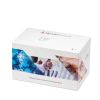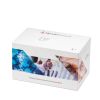RNase 7, Human, ELISA kit – 1 x 96 det. - HK371-01
RNase 7 is an protein secreted by a variety of epithelial tissues and is a member of the RNase A superfamily. This family shares sequence and structural similarities such as conserved cysteine residues as well as conserved histidines and a lysine in the active center catalysing the ribonuclease activity.
Quantity
1 x 96 det.
Catalog #
HK371-01
825,00 €
Antimicrobial proteins (AMP) are a fundamental element of the primary response against pathogens. AMPs are small endogenous cationic molecules expressed by phagocytic and epithelial cells. The antimicrobial activity of AMPs is directed towards a broad spectrum of pathogens, like Gram-positive & negative bacteria, viruses, yeast and fungi. AMPs aid in innate and adaptive immunity via direct inactivation and by immunomodulatory activity like leukocyte migration. RNase 7 is an protein secreted by a variety of epithelial tissues and is a member of the RNase A superfamily. This family shares sequence and structural similarities such as conserved cysteine residues as well as conserved histidines and a lysine in the active center catalysing the ribonuclease activity. RNase 7 is a 14.5 KDa protein with distinct ribonuclease activity. However, the antimicrobial activity is independent form the ribonuclease activity which might be associated with antiviral activity. On a per molar basis, RNase 7 is one of the most potent AMPs. RNase 7 contributes to the sterility in several systems. It is described to be important in sterility of the kidney and urinary tract as well as its contribution to the skin barrier protection. In the urinary system it is constitutively expressed by the intercalated cells in the renal collecting tubules and is present in the urine at such levels to kill bacteria at baseline. In the skin it contributes to control the growth of microorganisms on the skin surface, and the expression levels can be further induced under control of proinflammatory cytokines. The bactericidal activity of RNase 7 has been associated with its ability to bind and permeate the bacterial cell membrane. This requires clustering of lysine residues. RNase 7 is able to bind LPS and peptidoglycans. In ocular surface, signal transduction associated with RNase 7 expression is mediated via MAPKs but not NF-κB signalling pathways. IL1β leads to an increased expression of RNase 7.
| Datasheet URL | https://www.hycultbiotech.com/wp-content/uploads/2022/06/HK371-0615.pdf |
|---|---|
| Quantity | 1x96det. |
| Quantity | 1 x 96 det. |
| Standard range | 78.1 to 5000 pg/ml |
| Detection level | 78.1 pg/ml |
| Working volume | 100 µl/well |
| Species | human |
| Alias | RNase7, Ribonuclease 7, Skin-derived antimicrobial protein 2 |
| Application | The human RNase 7 ELISA kit is to be used for the in vitro quantitative determination of human RNase 7 in serum, plasma, bronchoalveolar lavage fluid, urine and cell culture supernatant samples. |
| Principle | The human RNase 7 ELISA is a ready-to-use solid-phase enzyme-linked immunosorbent assay based on the sandwich principle with a working time of 3½ hours. The efficient format of a plate with twelve disposable 8-well strips allows free choice of batch size for the assay. Samples and standards are incubated in microtiter wells coated with antibodies recognizing human RNase 7. Biotinylated tracer antibody will bind to the captured human RNase 7. Streptavidin-peroxidase conjugate will bind to the biotinylated tracer antibody. Streptavidin-peroxidase conjugate will react with the substrate, tetramethylbenzidine (TMB). The enzyme reaction is stopped by the addition of oxalic acid. The absorbance at 450 nm is measured with a spectrophotometer. A standard curve is obtained by plotting the absorbance (linear) versus the corresponding concentrations of the human RNase 7 standards (log). The human RNase 7 concentration of samples, which are run concurrently with the standards, can be determined from the standard curve. |
| Storage and stability | Product should be stored at 4 °C. Under recommended storage conditions, product is stable for at least six months. |
| Precautions | For research use only. Not for use in or on humans or animals or for diagnostics. It is the responsibility of the user to comply with all local/state and Federal rules in the use of this product. Hycult Biotech is not responsible for any patent infringements that might result with the use of or derivation of this product. |
| References | 1. Köten B, Simanski M, Gläser R, Podschun R, Schröder J-M, et al. (2009) RNase 7 Contributes to the Cutaneous Defense against Enterococcus faecium. PLoS ONE 4(7): e6424 2. Schwaderer A, Wang H, Bartz J, Kline J, Eichler T, DeSouza K, Sims-Lucas S, Baker P, D (2013) Ribonuclease 7, an antimicrobial peptide up-regulated during infection, contributes to microbial defense of the human urinary tract. Kidney Int. 83(4): 615–625. 3. Becknell B, Eichler T, Beceiro S, Li B, Easterling R, Carpenter A, James C, McHugh K, Hains D, Partida-Sanchez S, Spencer J. (2014) Ribonucleases 6 and 7 have antimicrobial function in the human and murine urinary tract. Kidney Int. 2014 Jul 30 |
| Disease | Infectious diseases, Nephrology |
| Application assays: | The human RNase 7 ELISA kit is to be used for the in vitro quantitative determination of human RNase 7 in serum, plasma, bronchoalveolar lavage fluid, urine and cell culture supernatant samples. |
|---|---|
| Principle: | The human RNase 7 ELISA is a ready-to-use solid-phase enzyme-linked immunosorbent assay based on the sandwich principle with a working time of 3½ hours. The efficient format of a plate with twelve disposable 8-well strips allows free choice of batch size for the assay. Samples and standards are incubated in microtiter wells coated with antibodies recognizing human RNase 7. Biotinylated tracer antibody will bind to the captured human RNase 7. Streptavidin-peroxidase conjugate will bind to the biotinylated tracer antibody. Streptavidin-peroxidase conjugate will react with the substrate, tetramethylbenzidine (TMB). The enzyme reaction is stopped by the addition of oxalic acid. The absorbance at 450 nm is measured with a spectrophotometer. A standard curve is obtained by plotting the absorbance (linear) versus the corresponding concentrations of the human RNase 7 standards (log). The human RNase 7 concentration of samples, which are run concurrently with the standards, can be determined from the standard curve. |





